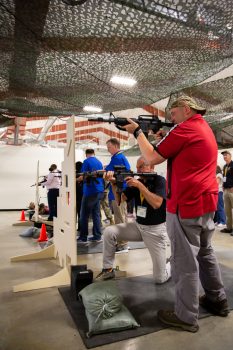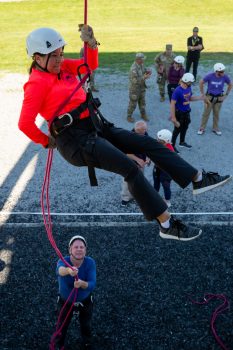
Army ROTC prides itself on finding the best and brightest students in the country, but this mission cannot be accomplished without proper mentorship at the university level.
“I think that there is a danger in academia of having a nose buried in the book,” said Kelby Woodard, Headmaster of Saint Thomas Academy. “I think seeing how it actually is done on the ground, in action, is really important, for academia in particular, or else they get out of touch.”
Woodard, along with a handful of other faculty members of various schools and universities, was chosen to visit Cadet Summer Training at Fort Knox, KY, on a temporary stay this week as a “COI,” or a Center of Influence for his organization. The goal: Learning.
“I’ve already talked to a few of my colleagues who have learned a lot from this visit already,” said Cameron Cook, Director of Veteran’s Resource Center, California State University, Fullerton. “Everybody is real hungry to learn.”
However, these COIs come from a background of constant learning already, so what’s different now? What changed in this visit was the emphasis on doing.
These COI volunteered for the opportunity to come from all across the country to get a hands-on look at what Cadet Summer Training is like for young officers in training, and they relished each event as they engaged in parts of training themselves.
Learning the basics of rifle shooting in a simulated trainer, or barreling down ropes on a 64-foot rappel tower were the aspects that brought these academics out of their elements, and into the boots of a Cadet.
But why is it important for them to learn about Army ROTC?
As members of organizations that work directly with the recruiting of Army ROTC Cadets, these faculty members wish to bring back the knowledge necessary to bridge the divide of misunderstanding between the military, and the civilian world.
Their goal is to tell the true story of the Army ROTC program to all who might want to hear it.
“I think ROTC can seem kind of ambiguous … this is the behind the scenes. This is where they really get that real hands-on training so it’s really good for the institutions to get a full vision of what the program is,” said Cook. “It’s so that the universities can collaborate better with ROTC and help them find more students with talent and leadership.”

Information is vital both to individuals in Army ROTC programs, and to students who might consider joining.
“I wish that more people would have a chance to do something like this, so that they can learn more about the Officer Corps and appreciate it more,” said Jim Prince of California Polytechnic State University.
At the end of the day, this week was about creating an understanding of Army ROTC.
As a member of his university’s College of Agriculture, Food, and Environmental Sciences, Prince shared a good analogy: “Many people have no clue what it takes to produce a meal. Same thing with the Army. Fewer and fewer people have anyone in their family who have been in the Army. People who don’t understand and appreciate things take them for granted.”




